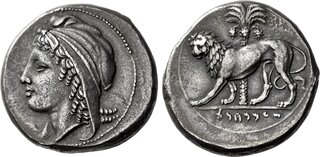| Numismatica Ars Classica > Auction 146 | Auction date: 8 May 2024 |
| Lot number: 2127 Price realized: This lot is for sale in an upcoming auction - Bid on this lot  | Show similar lots on CoinArchives Find similar lots in upcoming auctions on |
| Lot description: The Carthaginians in Italy, Sicily, Sardinia and North Africa. Tetradrachm, uncertain mint in Sicily circa 320, AR 26 mm, 16.80 g. Female head l., wearing oriental tiara with plain band before forehead. Rev. Lion walking l., with head facing; behind, palm tree with three clusters of dates. In exergue, s'mmhnt (People of the Camp) in Punic characters. Rizzo pl. LXVI, 6 (these dies). Jameson 911 (these dies). SNG Lloyd 1628 (these dies). Kraay-Hirmer pl. 73, 209 (these dies). Jenkins Punic Sicily III, 270. Extremely rare and in unusually fine condition for this difficult issue. A masterpiece of Carthaginian coinage of excellent Hellenistic style. Struck on a very broad flan and with a pleasant old cabinet tone. About extremely fine / good very fine Privately purchased from Harlan J. Berk in 1997. Within the large series of Siculo-Punic coins issued for Carthaginian military campaigns in Sicily, the "Queen Dido" tetradrachms are isolated and distinct. They consist of three individual issues, each produced by a single pair of dies, none of which are linked. All three bear the Punic inscription s'mmhnt (people of the camp) and share the same design type, yet each provides details that make it distinctive. Based upon this, it would seem that at least two, perhaps three artists were employed to cut the dies. As Jenkins observed, the engraving style of the "Dido" heads shares features with some other Siculo-Punic issues – a good reason to believe these masterful dies were cut by artists who had worked on other types. The engravers simply modified the familiar, Euainetos-inspired Artemis-Arethusa by the addition of the oriental tiara or Phrygian cap. The results of that modification were spectacular, and they are widely considered to be masterpieces of Sicilian Greek die engraving. Based upon stylistic affinities with other Siculo-Punic tetradrachms, Jenkins concludes they must have been struck in about 320 B.C., or "during the following years". If struck closer to c.315, he notes they may have been produced for Hamilcar, son of Gison, who was then preparing for war against the Syracusan King Agathocles. It is possible they were intended for the elite battalion of 2,000 citizens leading the new armada. The head on the obverse has been the subject of much debate. It is possible that her traditional identification as Dido/Elissa, a historical figure credited with the foundation of Carthage, is accurate. She was the sister of the Tyrian king Pygmalion and a great-niece of Jezebel, wife of King Ahab of Israel, and would have been valued as a founder-figure. In his final analysis, Jenkins identifies her as Artemis-Tanit, for Artemis wears similar headgear on some Attic and Tarentine terracotta of the 4th Century B.C., and on some Sicilian terracotta of the same era she is associated with a lion or a palm tree, or both. He cites bilingual stelae inscribed in Phoenician and Greek which, in some respects, suggest Artemis was the Greek equivalent of Tanit. Such are the current theories, which always are subject to revision with a new observation or the discovery of tantalising evidence. Estimate: 40000 CHF |  |



